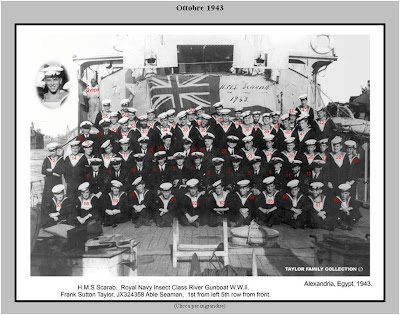"OPERATION FERDY" - 8 SEPT. '43: ALLIED LANDING AT VIBO VALENTIA MARINA, ITALY
8 sept. 1943. Italy was practically out of the war. Mussolini had been toppled from power and a fresh invasion was underway. A new Allied army, the Fifth under U.S. General Mark Clark was about to be landed at Salerno, just south of Naples. It was essential that Montgomery’s troops should join up with them. A lightning operation was planned with no time for rehearsals. The plan was to land a large body of troops behind enemy lines in the Italian ‘toe’. Their purpose was to interfere with enemy withdrawal, prevent demolition of roads and bridges and thus aid the advance of the British 8th Army.
The landing was to take place at Vibo Valentia Marina, a little port 25 miles up the toe of Italy. Wooded hills rise steeply above the road and railway along which the enemy’s guns and transport would have to pass.
24 landing craft ferried the troops accompanied by 18 tank landing craft and 2 tank landing ships carried the necessary guns and vehicles.
In support were Aphis and Scarab backed up by the monitor Erebus. With them were 2 Landing Craft (Gun) and 2 Landing Craft (Flak). Present in person aboard M.T.B. 77 was Rear-Admiral McGrigor to oversee the operation.
Although the landing was timed to commence at 2.30 am the night was very dark and Vibo Valentia’s breakwater impossible to locate. The flotilla cruised around for 90 nerve-wracking minutes while the beach party searched desperately for their landing place. Dawn was barely an hour away by the time that the assault craft at last received the landing signal.
Only slight opposition had been anticipated by the planners but in fact the coast road was thronged with retiring German troops fully equipped with artillery, mortars and machine-guns. They opened fire at once and pinned down the invaders almost before they managed to get off the beaches.
Aphis, Scarab and Erebus opened fire in support. As daylight came enemy fire grew more intense and in places German defenders broke through to within a few yards of the beaches. Dive bombing attacks developed in one of which Admiral McGrigor’s M.T.B. was near-missed, sunk and the admiral wounded. Undeterred he transferred his flag to a harbour defence motor launch.
Standing off the little bay Erebus and the two Insects were continuously in action. Shelling targets were signalled back to them by forward observation officers. Unfortunately one was killed and another lost touch with his bombarding ship. Until liaison was re-established supporting fire was badly compromised at a critical stage. If the soldiers were to avoid being driven back into the sea they urgently needed the guns and vehicles still on board the 2 tank landing ships.
Led by the Admiral in his motor launch the two vessels headed for the harbour.
One of them was soon in trouble but her consort zigzagged under the heavy fire, charged in and ran her bows up on the beach. She had been hit too many times on her way in and some of the vehicles set on fire. To make matters worse one of her bow doors jammed but by some miracle there happened to be a bulldozer on the beach and with its aid the damaged door was wrenched open. The guns went into action as soon as they were unloaded but the unfortunate L.S.T. remained where she was for many hours sustaining heavy damage and casualties from enemy shellfire.
Fighting raged all day with the Insects and Erebus slamming their 6 inch and 15 inch shells into the enemy at almost point-blank range. The fact that the German guns were all mobile made their work difficult. Although practically unscathed themselves the gunboats’ attendant landing craft fared badly, one of them having all her officers killed or wounded by a direct hit.
With nightfall fighting eased and by 11 pm the Germans had withdrawn. Erebus escorted the crippled landing ships back to Sicily but the Insects remained until Lt. Frank Bethell in Aphis was satisfied all enemy opposition had been overcome. The gunfire of these hard-hitting little ships had saved the day.
By the time Aphis and Scarab were able to withdraw from Vibo Valentia Marina the Allied landing at Salerno was in full swing.
Despite their usefulness the fact is often overlooked that they were elderly little ladies never intended for ocean operations. The venerable engines had to be carefully nursed and their thin, worn hulls constantly patched to withstand not just rough seas but the underwater concussion of exploding shells and bombs. Expendable yes, but uniquely valuable since they were of very shallow draught, reasonably speedy and manoeuvrable yet boasted a weight of shell equal to a destroyer.
Little more than flimsy floating platforms the gunboats were nearly helpless in large seas. Pushing head into the wind was unhelpful. The violent shock of pitching onto a flat bottom could not be endured by either crew or ship. Such “bumping” was actively dangerous since it hammered the hull plating and caused the superstructure to work back and forth loosening the securing rivets. For example the Insect Cricket required some 3,000 new rivets in her hull on arrival at Port Said after a short but rough voyage from Port Sudan.
Normally all small vessels were due for an overhaul and boiler clean after every thousand hours steaming but this was not always possible either because the ship could not be spared or because there was no dockyard berth free.
A good example is Cockchafer which when her engines had become urgently critical was sent wandering across to Malta, then to Benghazi, then Haifa on a variety of tasks until in May 1944 she arrived at Suez where the needs of her protesting machinery could finally receive attention.
But early in September, Cockchafer, Aphis and Scarab were retained along with Erebus to continue to aid the advance of the 8th Army which they did sharing the army’s calls for flank bombardments with destroyers and light craft.
28th Arrived Augusta departed 29th.
30th Arrived Malta.
In October the Admiralty informed the C.I.C. Mediterranean that the three Insects would remain at his disposal but that they should be refitted one at a time and modernised. This was to be deferred time and again.
The two Allied armies in Italy, the 5th on the west and the 8th on the east slowly forged northward against tough German opposition with the climatic obstacles of rain and snow, swollen rivers and glutinous mud which beset their efforts with the onset of winter. Each defensive river line was bitterly contested by the Germans under Kesselring.
Aphis and Scarab joined Cockchafer at Suez for overhaul and were fitted with a fresh pair of 6 inch guns apiece. Though these were not new they were a much later model and capable of effective fire at much greater range. In addition Aphis and Cockchafer were re-equipped with radar and Scarab given a VHF wireless set. Lieutenant Cameron was replaced by Lieutenant Edward Albert Hawkesworth, Royal Naval Volunteer Reserve in February 1944
While in dockyard fuel capacity and endurance were checked. Capacity was similar for all three – 106 tons but endurance range differed. Cockchafer’s was nearly 200 miles less than her sisters and speed slower probably due to the poor condition of her engines and boilers. Maximum endurance range for Aphis and Scarab was a little over 800 nautical miles
L'esperienza vissuta dallo Scarab, dall'Erebus e dall'Aphis nel settembre ed ottobre del 1943 è interamente tratta dal sito web dedicato al diario dell'equipaggio dello Scarab, vedi link., estratto dal sito www.frankstaylorfamilyandroyalnavyhistory.net . Per conoscere i nomi e le foto dell'intero equipaggio, vedi link







Commenti